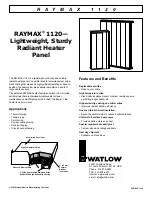
21
PERIODIC MAINTENANCE
VENTING SYSTEM INSPECTION
At least once a year a visual inspection should be made of the venting
system. You should look for:
1. Obstructions which could cause improper venting. The
combustion and ventilation air flow must not be obstructed.
2. Damage or deterioration which could cause improper venting
or leakage of combustion products.
3. Rusted flakes around top of water heater.
Be sure the vent piping is properly connected to prevent escape
of dangerous flue gases which could cause deadly asphyxiation.
Obstructions and deteriorated vent systems may present serious
health risk or asphyxiation.
Chemical vapor corrosion of the flue and vent system may occur
if air for combustion contains certain chemical vapors. Spray can
propellants, cleaning solvents, refrigerator and air conditioner
refrigerants, swimming pool chemicals, calcium and sodium chloride,
waxes, bleach and process chemicals are typical compounds which
are potentially corrosive.
If after inspection of vent system you found sooting or deterioration,
something is wrong. Call the local gas utility to correct problem and
clean or replace the flue and venting before resuming operation of
water heater.
BURNER INSPECTION
Flood damage to a water heater may not be readily visible or
immediately detectable. However, over a period of time a flooded
water heater will create dangerous conditions which can cause
DEATH, SERIOUS BODILY INJURY, OR PROPERTY DAMAGE.
Contact a qualified installer or service technician to replace a flooded
water heater. Do not attempt to repair the unit! It must be replaced!
At least once a year a visual inspection should be made of the main
burner and pilot burner, see Figure 19. Inspect burner fl ames through
viewport. Flames should be very small with a blue haze and small
amounts of yellow or orange at the edges. After several minutes of
operation the burner screen may glow red.
You should check for sooting. Soot is not normal and will impair
proper combustion.
Soot build-up indicates a problem that requires correction before
further use. Turn “OFF” gas to water heater and leave off until
repairs are made, because failure to correct the cause of the
sooting can result in a fire causing death, serious injury, or
property damage.
Flame Characteristics
Correct Flame
Red/Orange
FIGURE 19.
Natural Gas (Low Nox)
Burner Door Assembly
Use brush on this surface
Burner
Pilot Assembly
FIGURE 20.
BURNER CLEANING
If inspection of the burner shows that cleaning is required, turn
the gas control knob clockwise (
) to the “OFF” position,
depressing slightly.
NOTE: The knob cannot be turned from “PILOT” to “OFF”
unless knob is depressed slightly. DO NOT FORCE.
Check the burner to see if it’s dirty or clogged. The burner may be
cleaned with a soft paint brush, see Figure 20. Do not use a wire
brush or any tool that may damage the burner screen. Important: Do
not use the burner if the burner screen is damaged. NOTE: Damage
may be rips or holes in the burner screen. Discoloration is normal.
HOUSEKEEPING
Fire and Explosion Hazard
Do not obstruct combustion air
openings at the bottom of the
water heater.
Do not use or store flammable vapor
products such as gasoline, solvents
or adhesives in the same room or area
near water heater or other appliance.
Can cause serious injury or death.
Vacuum around base of water heater for dust, dirt, and lint on a
regular basis.















































